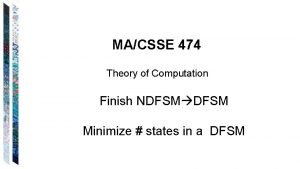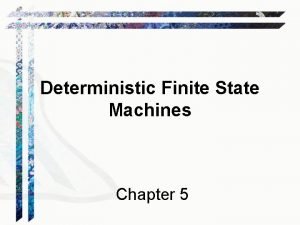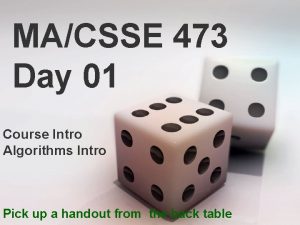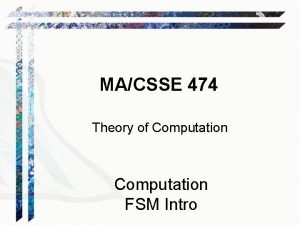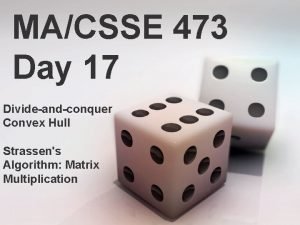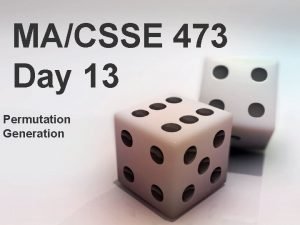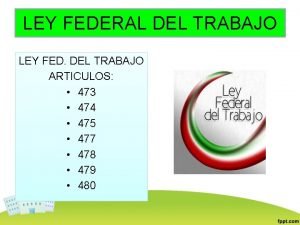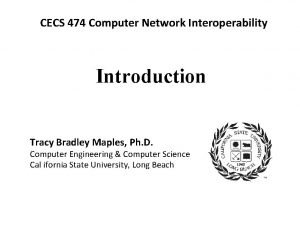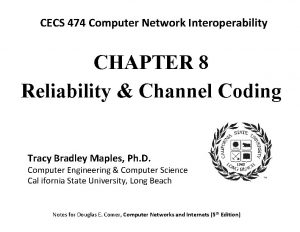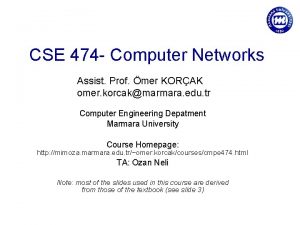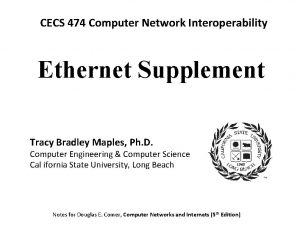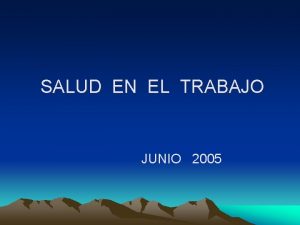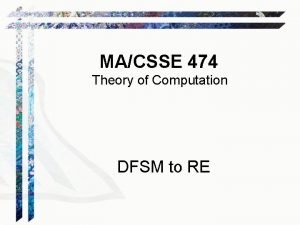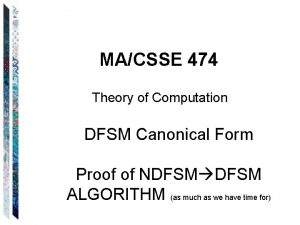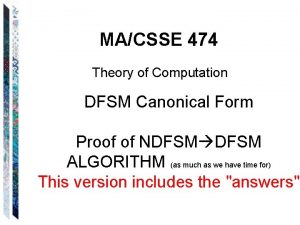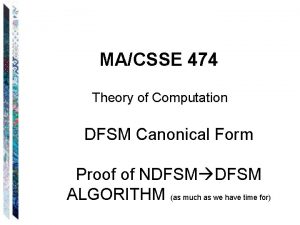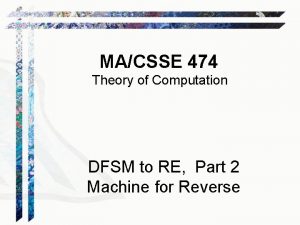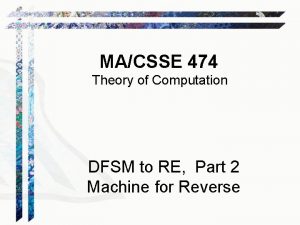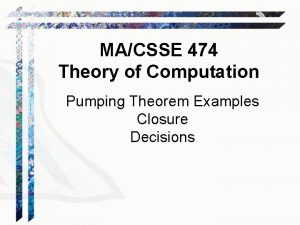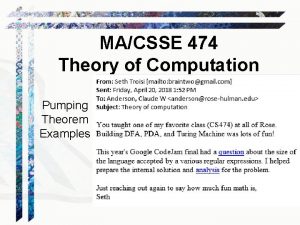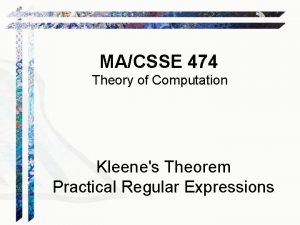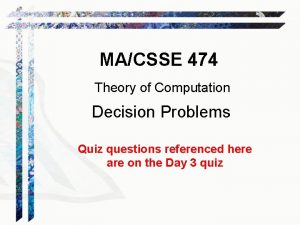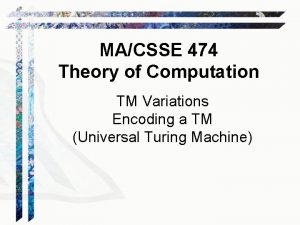MACSSE 474 Theory of Computation DFSM to RE












- Slides: 12

MA/CSSE 474 Theory of Computation DFSM to RE, Part 2 Machine for Reverse

Your Questions? • Previous class days' material • Reading Assignments • HW 6 or 7 problems • Exam 1 questions • Anything else

Recap: Kleene’s Theorem Finite state machines and regular expressions define the same class of languages. To prove this, we must show: Theorem: Any language that can be defined by a regular expression can be accepted by some FSM and so is regular. Done Days 11 -12. Theorem: Every regular language (i. e. , every language that can be accepted by some DFSM) can be defined with a regular expression. We will review what we did Day 12, and finish the algorithm and example today.

For Every FSM There is a Corresponding Regular Expression • We’ll show this by construction. The construction is different than the textbook's. • Let M = ({q 1, …, qn}, , , q 1, A) be a DFSM. Define Rijk to be the set of all strings x * such that • (qi, x) |-M* (qj, ), and • if (qi, y) |-M* (q�� , ), for any prefix y of x (except y= and y=x), then �� k • That is, Rijk is the set of all strings that take us from qi to qj without passing through any intermediate states numbered higher than k. • In this case, "passing through" means both entering and immediately leaving. • Note that either i or j (or both) may be greater than k.

Example: Rijk • Rijk is the set of all strings that take us from qi to qj without passing through any intermediate states numbered higher than k. • In this case, "passing through" means both entering and leaving. • Note that either i or j (or both) may be greater than k. R 110 R 111 R 112 R 131 R 132 R 330 R 333 R 142 R 143

DFSM Reg. Exp. construction • Rijk is the set of all strings that take M from qi to qj without passing through any intermediate states numbered higher than k. • Examples: Rij 0 Rijn • We will show that for all i, j {1, …, n} and all k {0, …, n}, Rijk there is a regular expression rijk that defines Rijk. • Also note that L(M) is the union of R 1 jn over all qj in A. – We know that the union of languages defined by reg. exps. is defined by a reg. exp.

DFSM Reg. Exp. continued • Rijk is the set of all strings that take M from qi to qj without passing through any intermediate states numbered higher than k. It can be computed recursively: • Base cases (k = 0): – If i j, Rij 0 = {a : (qi, a) = qj} – If i = j, Rii 0 = {a : (qi, a) = qi} { } • Recursive case (k > 0): Rijk is Rij(k-1) Rik(k-1)(Rkk(k-1))*Rkj(k-1) • We show by induction that each Rijk is defined by some regular expression rijk.

DFSM Reg. Exp. Proof pt. 1 • Base case definition (k = 0): – If i j, Rij 0 = {a : (qi, a) = qj} – If i = j, Rii 0 = {a : (qi, a) = qi} { } • Base case proof: Rij 0 is a finite set of symbols, each of which is either or a single symbol from . So Rij 0 can be defined by the reg. exp. rij 0 = a 1 a 2 … ap (or a 1 a 2 … ap if i=j), where {a 1, a 2, …, ap} is {a : (qi, a) = qj. • Note that if M has no direct transitions from qi to qj, then rij 0 is (it is if i=j and no "loop" on that state).

DFSM Reg. Exp. Proof pt. 2 • Recursive definition (k > 0): Rijk is Rij(k-1) Rik(k-1)(Rkk(k-1))*Rkj(k-1) • Induction hypothesis: For each �� and �� , there is a regular expression r�� �� (k-1) such that L(r�� �� (k-1) )= R�� �� (k-1). • Induction step. By the recursive parts of the definition of regular expressions and the languages they define, and by the above recursive definition of Rijk : Rijk = L(rij(k-1) rik(k-1)(rkk(k-1))*rkj(k-1))

DFA Reg. Exp. Proof pt. 3 • We showed by induction that each Rijk is defined by some regular expression rijk. • In particular, for all qj A, there is a regular expression r 1 jn that defines R 1 jn. • Then L(M) = L(r 1 j 1 n … r 1 jpn ), where A = {qj 1, …, qjp}

An Example (rijk is rij(k-1) rik(k-1)(rkk(k-1))*rkj(k-1)) Start q 1 0 0 r 11 k r 12 k r 13 k r 21 k r 22 k r 23 k r 31 k r 32 k r 33 k k=0 0 1 0 1 0 1 q 2 1 k=1 0 1 0 00 1 1 q 3 0, 1 k=2 (00)* 0*1 0(00)* 0*1 (0 1)(00)*0 (0 1)(00)* (0 1)0*1

Another "machine construction" example Given a DFSM M=(Κ, Σ, δ, s, A) that accepts a language L(M), construct a FSM M' such that L(M') = L(M)R 1. Write a careful mathematical description of that machine 2. Prove that L(M') = L(M)R
